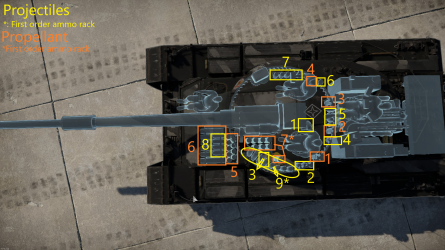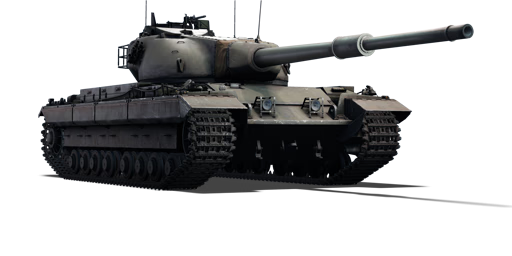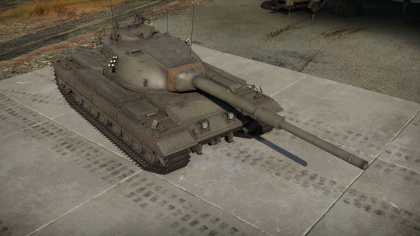Conqueror
Contents
Description
The Tank Heavy Gun Conqueror Mk.2 is a Rank V British heavy tank with a battle rating of 7.7 (AB/SB) and 7.3 (RB). It was released along with the initial British tree line in Update 1.55 "Royal Armour". Meant to defeat the Soviet IS-3, the Conqueror gives the British tree line an emphasis in armour and firepower, with a 120 mm gun able to contest the Rank V competitors.
The Conqueror shares the same hull as the Caernarvon, but features a completely new turret armed with the Ordnance QF 120 mm L1A1 gun. The turret is significantly better armoured than the Centurion turret used by the Caernarvon. In a hull-down position where the weak lower front plate is hidden, it can be a very difficult vehicle to destroy from the front. Unfortunately, the side and rear hull armour is very weak, although it is covered by a lot of spaced armour. Flanking the Conqueror usually results in its swift destruction.
The 120 mm gun used by the Conqueror is essentially a version of the American 120 mm Gun M58 used by the M103 heavy tank. Unfortunately, the British version does not have access to the extremely lethal American solid shot AP or HEAT ammunition. The Conqueror is thus forced to choose between the anaemic APDS or unreliable HESH ammunition, while also sharing the same long reload as the American gun.
In general, the APDS is quite accurate at long ranges thanks to its high velocity, and the high penetration usually means it will not have too many problems penetrating most things the Conqueror will encounter. However, the post-penetration effects of APDS tend to be very poor compared to full-bore AP, and it is very rare to one-shot opponents. This problem is further exacerbated by the Conqueror's long reload, which is longer than the time it takes to replace a crewmember if facing a opponent with good crew skills. The HESH round will do a lot of damage if it hits and penetrates, but is easily frustrated by spaced armour and external components like tracks or suspension elements. It also has a relatively low velocity and is harder to use at long ranges.
The mobility of the Conqueror is fair enough for a 65 t heavy tank, and is comparable to the Centurion.
General info
Survivability and armour
Armour type:
- Rolled homogeneous armour
- Cast homogeneous armour (Turret)
- Structural steel (Side skirts)
| Armour | Front | Sides | Rear | Roof |
|---|---|---|---|---|
| Hull | 130 mm (60°) Front glacis 76.2 mm (44°) Lower glacis |
50.8 + 4 mm | 38 mm Top 20 mm (61°) Bottom |
44 mm Front 17 mm Crew hatches 17 mm Rear |
| Turret | 152-313 mm (0-68°) Turret front 140-200 mm (0-78°) Gun mantlet |
89-313 mm (1-48°) | 50 mm (1-34°) | 50.8 mm 31 mm Square area near gun |
| Armour | Front | Rear | Roof | |
| Cupola | 203 mm (0-17°) | 70 mm (12-14°) | 50.8 mm 17 mm Crew hatches |
Notes:
- Suspension wheels and bogies are 20 mm thick while tracks are 30 mm thick.
- Front of turret vary in armour thickness, from 152 mm to 313 mm, but it is all very sloped due to turret design.
- The front of the turret roof has an additional armour plate of 31 mm in thickness.
Mobility
| Mobility characteristic | ||
|---|---|---|
| Weight (tons) | Add-on Armour weight (tons) |
Max speed (km/h) |
| 66.0 | 1.1 | 37 (AB) |
| 34 (RB/SB) | ||
| Engine power (horsepower) | ||
| Mode | Stock | Upgraded |
| Arcade | 1,046 | ____ |
| Realistic/Simulator | 716 | 810 |
| Power-to-weight ratio (hp/ton) | ||
| Mode | Stock | Upgraded |
| Arcade | 15.85 | __.__ |
| Realistic/Simulator | 10.85 | 12.27 |
Armaments
Main armament
| 120 mm L1A2 | |||||
|---|---|---|---|---|---|
| Capacity | Vertical guidance |
Horizontal guidance |
Stabilizer | ||
| 35 | -7°/+15° | ±180° | Two-plane | ||
| Turret rotation speed (°/s) | |||||
| Mode | Stock | Upgraded | Prior + Full crew | Prior + Expert qualif. | Prior + Ace qualif. |
| Arcade | 9.7 | __.__ | __.__ | __.__ | __.__ |
| Realistic | 9.7 | __.__ | __.__ | __.__ | __.__ |
| Reloading rate (seconds) | |||||
| Stock | Prior + Full crew | Prior + Expert qualif. | Prior + Ace qualif. | ||
| 19.4 | __.__ | __.__ | __.__ | ||
Ammunition
| Penetration statistics | |||||||
|---|---|---|---|---|---|---|---|
| Ammunition | Type of warhead |
Penetration in mm @ 90° | |||||
| 10m | 100m | 500m | 1000m | 1500m | 2000m | ||
| Shot L1G | APDS | 362 | 361 | 359 | 354 | 339 | 321 |
| Shell L1TK | HESH | 152 | 152 | 152 | 152 | 152 | 152 |
| Shell details | ||||||||||
|---|---|---|---|---|---|---|---|---|---|---|
| Ammunition | Type of warhead |
Velocity in m/s |
Projectile Mass in kg |
Fuse delay
in m: |
Fuse sensitivity
in mm: |
Explosive Mass in g (TNT equivalent): |
Normalization At 30° from horizontal: |
Ricochet: | ||
| 0% | 50% | 100% | ||||||||
| Shot L1G | APDS | 1493 | 7.6 | N/A | N/A | N/A | +1.5° | 75° | 78° | 80° |
| Shell L1TK | HESH | 792 | 16 | 0.4 | 0.1 | 3,100 | +0° | 73° | 77° | 80° |
Ammo racks

| Full ammo |
1st rack empty |
2nd rack empty |
3rd rack empty |
4th rack empty |
5th rack empty |
6th rack empty |
Recommendations | Visual discrepancy |
|---|---|---|---|---|---|---|---|---|
| 35 | 31 (+4) | 21 (+14) | 16 (+19) | 11 (+24) | 6 (+29) | 1 (+34) | No |
Keep ammo at around 16 (+19) or 11 (+24)
Machine guns
| 7.62 mm L3A1 | ||||||
|---|---|---|---|---|---|---|
| Coaxial mount | ||||||
| Capacity (Belt capacity) | Fire rate (shots/minute) |
Vertical guidance |
Horizontal guidance | |||
| 3,750 (250) | 500 | N/A | N/A | |||
| Pintle mount | ||||||
| Capacity (Belt capacity) | Fire rate (shots/minute) |
Vertical guidance |
Horizontal guidance | |||
| 3,750 (250) | 500 | -10°/+30° | ±90° | |||
Usage in the battles
The Conqueror performs best at longer ranges as a support tank where it can make the best use of its accurate, high-penetration 120 mm gun as well as its and heavy frontal armour, especially in terrain that allows it to go hull-down.
Modules
As per usual,"Parts" and "FPE" should be the focus first for modifications to increase combat survivability. Everything else is fair game after those two.
It is then recommended to head for the "Additional Ballistic Protection Package" in order to increase the armour of the Conqueror to stand up to more lethal rounds.
Pros and cons
Pros:
- 361 mm stock penetration with the high-velocity APDS.
- Accurate at long ranges.
- Turret is well armoured and well shaped to deflect rounds.
- HESH ammunition with good explosive filler,
- Extremely sloped and well-armoured upper glacis
- Both APDS and HESH ammunition rarely ricochet off tanks.
- The coaxial MG can be used as a ranging gun, its bullets land where the HESH shell will approximately hit.
- Now has add on armour, which offers more protection to the sides and front.
Cons:
- Poor lethality with APDS.
- Unreliable HESH ammunition that is harder to aim due to lower velocity.
- Long reload time.
- Very weak side hull armour.
- Only four crew members (crew can be easily knocked out).
- Top speed is subpar (33 km/h).
- Poor acceleration.
- Weak lower glacis plate.
History
Development
In 1944, General Staff started a project called A45 Infantry Support Tank, which started around the same time as the development of the A41 Centurion cruiser tank. This project, after the war, was redesignated from a typical "Infantry Tank" and instead focused on a new role of a "Universal Tank" design in the form of the FV 200 series. The "Universal Tank" concept was to design a vehicle that would have a mobility comparable to that of cruiser tanks, but with the armour and firepower of heavy tanks. The FV 200 series designation was adopted and was to serve as a line of vehicles that used the same hull and chassis in different roles like armour recovery vehicles and self-propelled guns. The first tank of this series was to be the FV 201, which would be 55 tons and use the 20-pounder gun.
In 1949, a new requirement for the project called for the use of a 120 mm gun, possibly in response to the reveal of the Soviet IS-3 heavy tank in the Berlin Victory Parade in 1945. This new requirement would delay the initial deadlines for the tank as no gun of that caliber had been developed yet. As a interim development before such a gun could be made, the FV 201 hull was mounted with a turret from the Centurion tank and this created the FV 221 Caernarvon, with Mark I for a 17-pounder armament and a Mark II for a 20-pounder armament. However, the success of the lighter Centurion tank made the Caernarvon unsuitable in a "Main Battle Tank" role. Further development on the Caernarvon, with emphasis on the armour and armament, would develop the FV 214 Conqueror tanks, some were straight up conversions of Caernarvon Mark II's. About 185 Conquerors were produced in Mk.1 and Mk.2 variants from 1955 to 1959.
Design
The FV 214 Conqueror, also known as the "Tank, Heavy No. 1, 120 mm Gun, Conqueror", was intended to provide a mobile, long-range anti-tank support for the lighter and more numerous Centurion tanks stationed in Germany. As a response to the heavy IS-3 tank in Soviet service, the tank's armament and armour is taken up and beyond extreme to typical NATO armour development. The armour, with a frontal plate of about seven inches (178 mm), made the tank one of the most protected tanks stationed in West Germany. The abundance of armour made the tank heavy, weighing 64 tons, and this impeded the tank's top speed and made it mechanically unreliable. However, the tank was very mobile in cross-country terrain, seen as equal as the lighter and faster Centurion tank.
The gun was the very large 120 mm cannon, the largest caliber tank gun available when it was introduced. The gun was American-developed, the same 120 mm cannon that would arm the M103 heavy tank. The gun uses a two-piece ammunition and the tank allowed for a ammo stowage of 35 rounds. Another notable feature of the Conqueror aside from its large cannon and thick armour was the unique and rotatable commander's cupola. In the cupola was the Conqueror's fire control system and had many features that made it ahead of its time. Being able to be rotated independent from the turret, plus with a coincidence rangefinder, the commander could align the cupola to a target, measure its range, and direct the gunner to the designated target. While the gunner located and engage the target, the commander could go and find a different target to designate and range.
Usage
The Conqueror were all stationed in West German in the armoured regiments stationed there. Each regiment received 9 Conquerors and were organized in groups of three as tank troops to support the Centurions in any conflict that arise from the tense situation of the Cold War. As history played out, the Cold War never became "hot" and no hostile conflicts arise in the borders of Germany, thus the Conquerors never saw any use aside from training as they were all exclusively stationed on the German borders. The Conqueror's intention to provide a long-range anti-tank capability for the Centurions, became less significant when the Centurions began to arm themselves with the more powerful 105 mm L7 gun, such as the Centurion Mk 10. The lower tactical value of the Conqueror and further development on heavy tanks in Britain had the Conquerors replaced in 1966 with the much more powerful and armoured, yet lighter, FV 4201 Chieftain tank.
Media
An excellent addition to the article will be video guides, as well as screenshots from the game and photos.
Read also
Sources
Paste links to sources and external resources, such as:
- topic on the official game forum;
- other literature.
| Britain heavy tanks | |
|---|---|
| Matilda | Matilda III · Matilda Hedgehog |
| Churchill | Churchill I · Churchill III · Churchill VII · Churchill Crocodile · Churchill NA75 · Black Prince |
| Post-war | Caernarvon · Conqueror |
| Other | Independent · Excelsior · TOG II |





